This homemade vegan Italian dressing is so quick and easy to prepare, and it’s even more flavorful than the store-bought version! Herbs, good olive oil, and a nutritious vegan parmesan cheese, which is made with cashews and nutritional yeast, contribute to its savoriness and complexity.
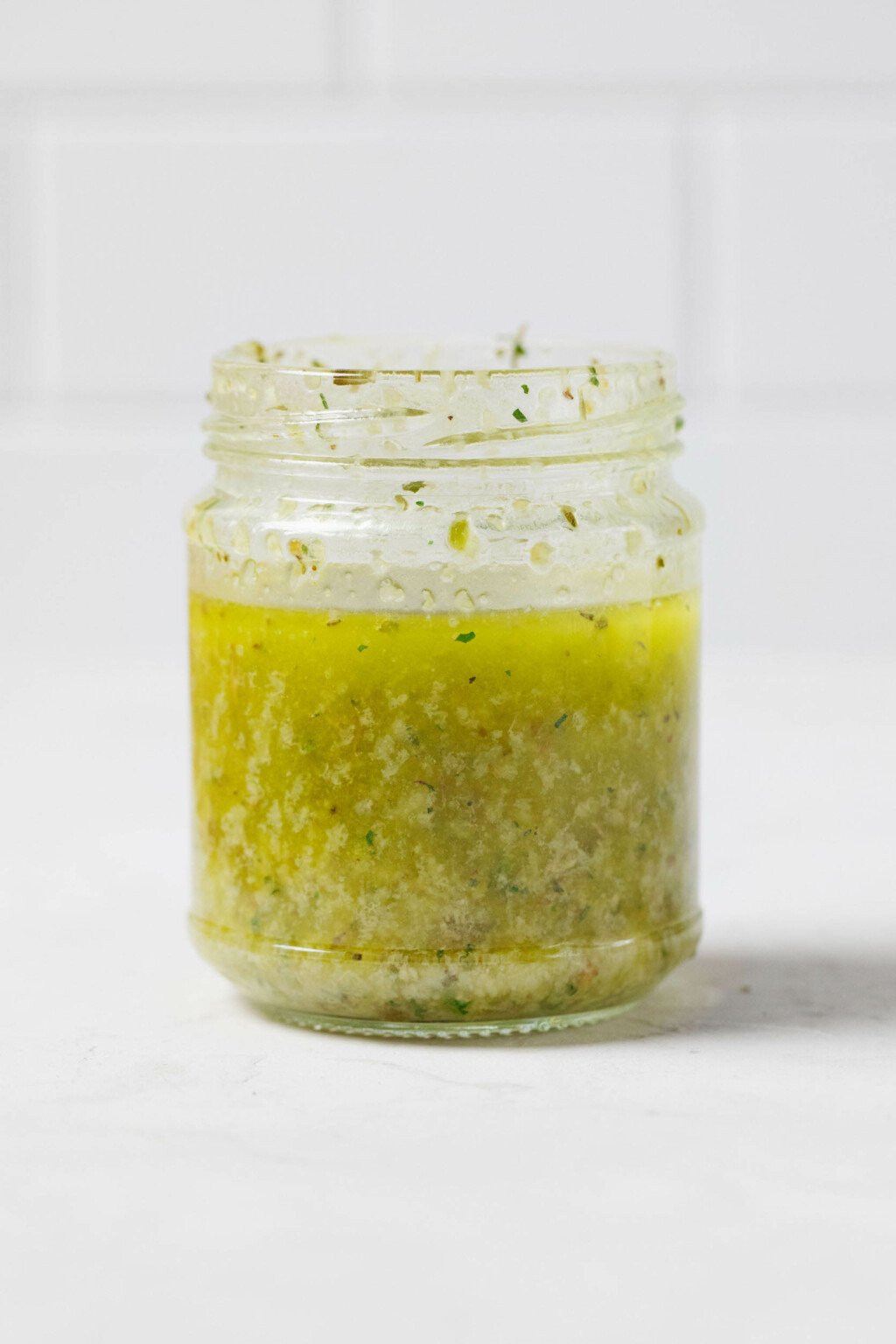
A lot of the recipes that I posted on this blog last year could be categorized as vegan basics.
What’s a “basic” within the world of recipes?
In my mind, basics are kitchen staples. They’re things to make often and keep on hand regularly.
Basics are recipes with a lot of utility. Examples might be a favorite sauce, a versatile protein, or a non-dairy version of a popular condiment. Basics can find their way into countless meals or recipes.
Vinaigrettes are wonderful basics. Yes, they can always be put onto a salad. But a jar of vinaigrette always finds multiple uses in my home.
I use vinaigrettes to season cooked whole grains. I drizzle them onto roasted vegetables for extra flavor. Sometimes I use them to dress ingredients that I put into a wrap or a sandwich.
I always read that making a good vinaigrette is all about remembering a certain ratio of ingredients; in other words, there’s no need for a recipe.
To be honest, though, I don’t think it hurts to work from a recipe. Recipes are formulas that other people can vouch for.
And I can definitely vouch for this vegan Italian dressing.
What is Italian dressing?
When I hear “Italian dressing,” my mind goes directly to the store-bought bottles of Italian dressing that I grew up with.
These were, in fact, American Italian dressings. So far as I know, they’re not the common dressing for salads in any part of Italy.
The typical ingredients in commercial American Italian dressing are:
- Water
- Oil
- Sugar
- Salt
- Dried garlic
- Dried red bell pepper
- Oregano
- Lemon
You’ll see some of these same ingredients in the vegan Italian dressing that I’m sharing today. Yet if you make the dressing, I think you’ll find that it tastes different from whatever store-bought bottle you might have grown up with.
Somehow, commercial Italian dressing has always tasted a bit canned to me. And, while I like a touch of sweetness in my dressings, the store-bought versions often strike me as overly sweet.
This homemade Italian dressing should taste fresh and zippy. The garlic has a little bite, the herbs are distinctive, and the acidity is assertive.
Is Italian dressing vegan?
Some Italian dressings have some creaminess from added milk or buttermilk. However, most traditional Italian dressings are vegan, in that they don’t contain dairy, cheese, or egg.
Funnily enough, my vegan Italian dressing does contain cheese—vegan cheese, that is!
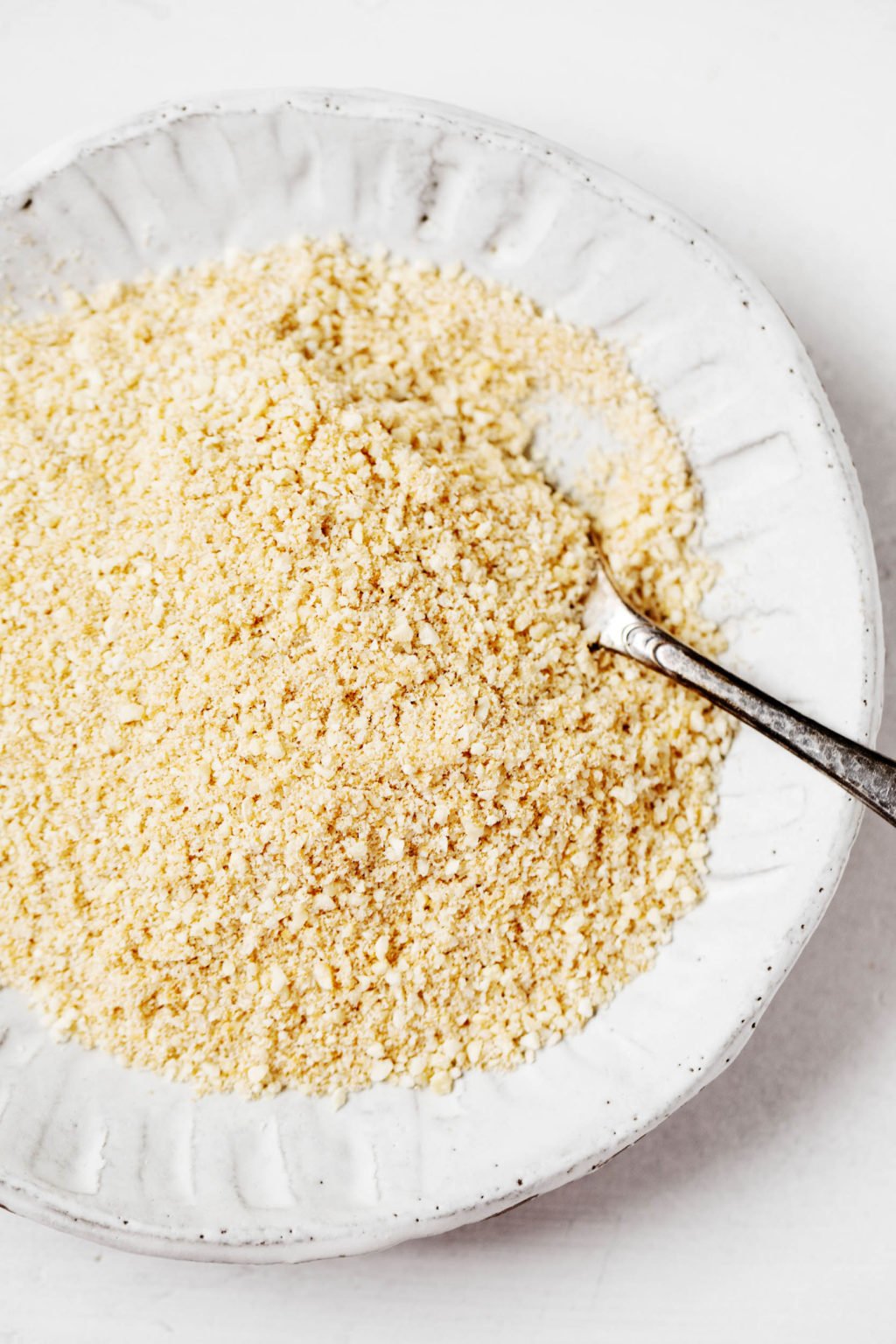
I use my vegan cashew parmesan cheese for savory flavor and a little texture.
The parmesan recipe contains nutritional yeast, which is usually described as tasting savory and “cheesy.” Nutritional yeast is a source of glutamate, which is the amino acid that’s associated with umami.
If you don’t want to make vegan parmesan from scratch, it’s fine to use store-bought vegan parmesan instead.
And if you’d like to skip the cashew parmesan cheese, that’s OK, too. The vegan Italian dressing will still have plenty of flavor.
Vegan Italian dressing ingredients
What are the ingredients that give this vinaigrette its flavor? They’re pretty uncomplicated, and in fact, all of them might be tucked away in your fridge and pantry right now.
Olive oil
Most of my vinaigrette recipes begin with olive oil. I recommend extra virgin olive oil, which is known for being especially flavorful.
Your olive oil can be peppery or buttery, green or golden, punchy or a little more mild. It’s really up to you.
In place of olive oil, you can use avocado oil, which will taste more neutral.
White wine vinegar
White wine vinegar is my favorite for Italian dressing. It’s sharp, yet not quite as sharp or acidic as red wine vinegar (which is the vinegar that I use for my Greek vinaigrette—also a favorite!).
White wine vinegar is different from distilled white vinegar. Theoretically, you can use either in this recipe, but I think white wine vinegar is quite a bit more flavorful.
If you need to make a substitute, I recommend using champagne vinegar or red wine vinegar in its place.
Maple syrup
I mentioned that I like a touch of sweetness in my dressings, especially vinaigrette-style dressings. This is because I think that a hint of sweet flavor balances the acidity of lemon or vinegar in a nice way.
You certainly don’t have to add a lot of sweetener to this Italian dressing, or any other of my dressings. I use a scant teaspoon of maple syrup here, and for some other dressings I use even less.
If you like, you can omit the syrup. You can also substitute agave syrup for maple, if you like.
Garlic
Garlic is part of this vinaigrette’s assertive flavor. Even when garlic plays an important role in one of my recipes, I have less tolerance for raw garlic than most people do. So I stick to one (larger) clove for my Italian dressing.
Feel free to increase the garlic to two cloves, if you like. I recommend mincing the garlic as finely as possible, or grating it into the dressing with a fine microplane zester.
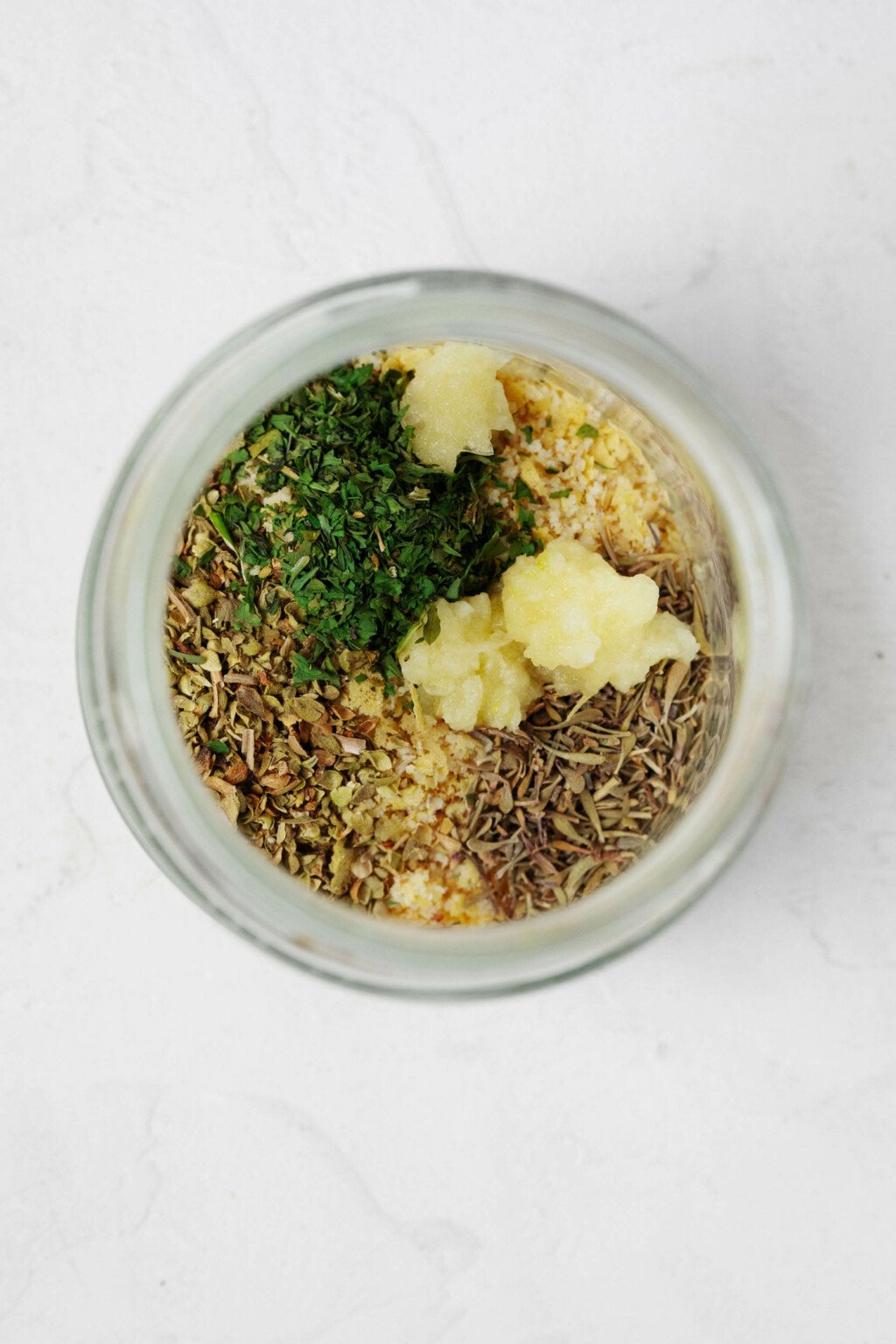
Herbs
I nearly always keep a jar of Italian seasoning—dried oregano, marjoram, thyme, basil, rosemary, and sage—in my pantry.
Yes, I could add each of these dried spices to recipes, rather than purchasing the mix, but I like the collective effect without having to rummage around for multiple jars. (And I’m not sure how much use marjoram would get in my kitchen as a solo ingredient.)
Italian seasoning is what you’ll see listed in the recipe, but it’s also fine to use a half teaspoon each dried basil, oregano and thyme. If you have marjoram and sage and would like to add a pinch of those, too, go for it.
What about fresh herbs?
I actually prefer to use dried herbs in my dressing. The dressing will have longer shelf life in the fridge if it has dried herbs, and their fine texture works well for vinaigrettes.
However, if you have a lovely little herb garden, then by all means, feel free to use fresh, finely chopped basil, little oregano leaves, and chopped fresh thyme instead. I’d recommend substituting a tablespoon of each of these for the half teaspoon of each type of dried herb.
Cashew parmesan cheese
Cashew parmesan cheese will give the Italian dressing a depth of flavor and savoriness that’s special.
I sort of love how it adds a little texture, too—not enough to be grainy, but just enough to give any simple green salad some mouthfeel.
In place of my homemade version, I like the Parma brand’s vegan parmesan in the original flavor. Follow Your Heart’s grated parmesan is nice, too.
Another option: just use nutritional yeast. It won’t add quite the same texture that vegan parmesan does, but it will still give the vinaigrette that bit of umami.
Salt and pepper
These go without saying as seasonings for the vinaigrette. But I think it’s always smart to taste a salad after dressing it, even if there’s vinaigrette on it, and adding extra salt and pepper as needed.
How to make vegan Italian dressing
Part of the beauty of a vinaigrette is ease of preparation. There are two things that you’ll need to do in order to make better-than-store-bought Italian dressing.
Ready?
Step 1: Place all ingredients into a mason jar (or another airtight storage container with a lid)
Step 2: Shake!
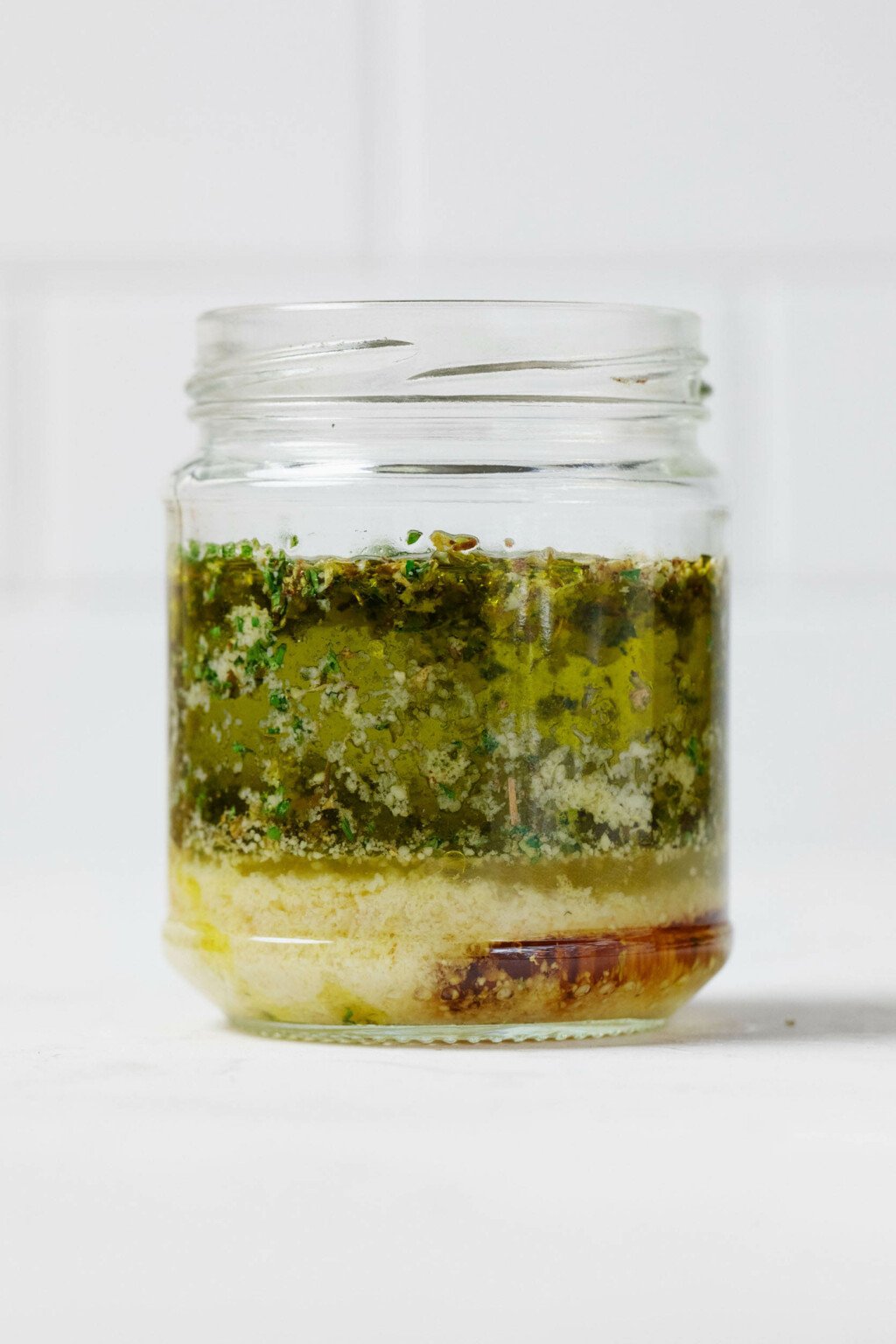

Vigorous shaking is enough to emulsify this particular salad dressing.
If you prefer, though, you can place your ingredients into a jar, then use a small whisk or a fork to whisk it together instead.
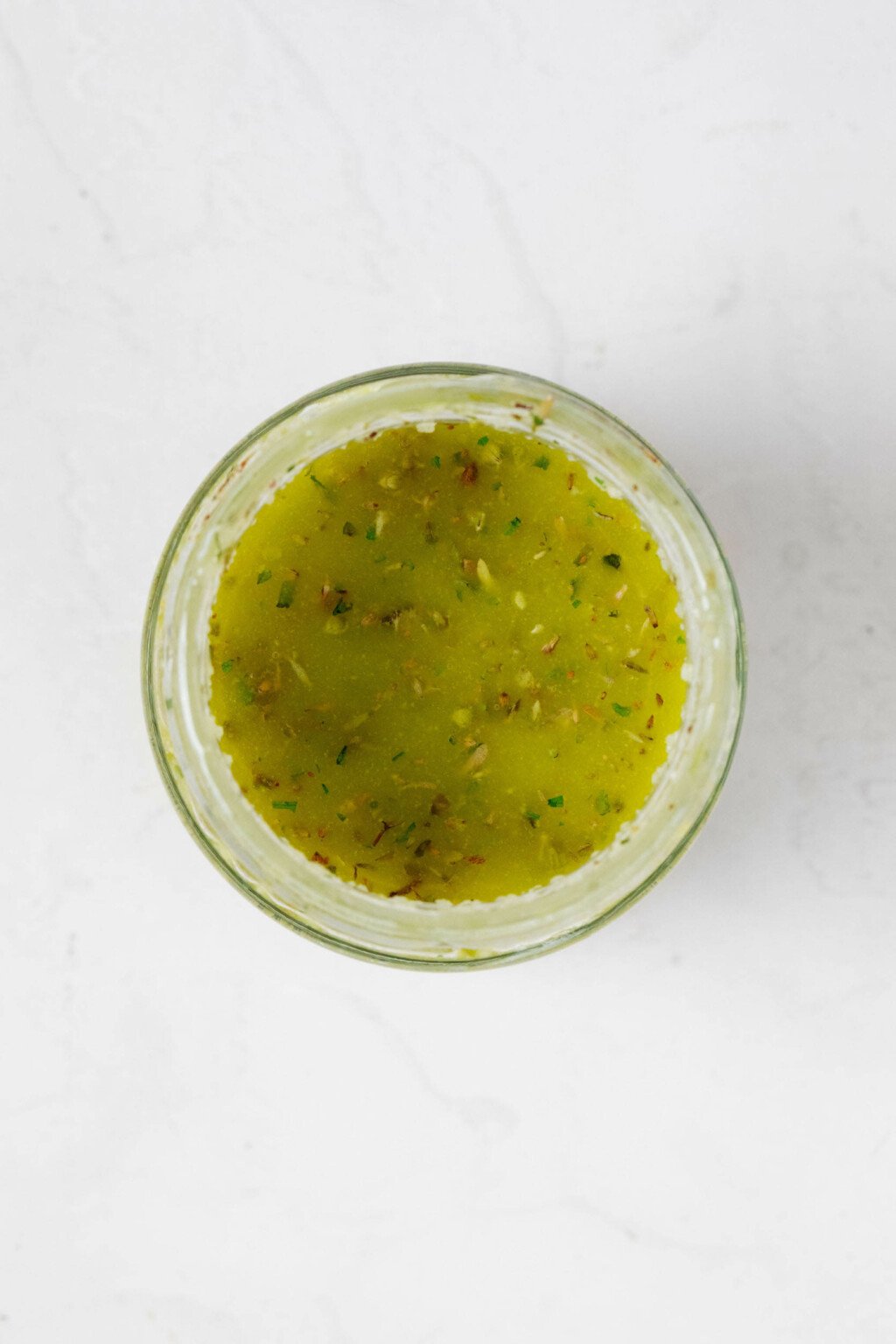
Meal prep and storage
Once made, the Italian dressing can be stored in an airtight container (I use the same jar that I prepared it in) in the fridge for up to a week.
By the way, if you’ve ever been curious, you can freeze vinaigrettes.
I tend to prefer the flavor of vinaigrettes when they’re freshly made. But if you have extra and don’t want to waste it, they can be frozen for up to 8 weeks, then defrosted in the fridge till liquid again.
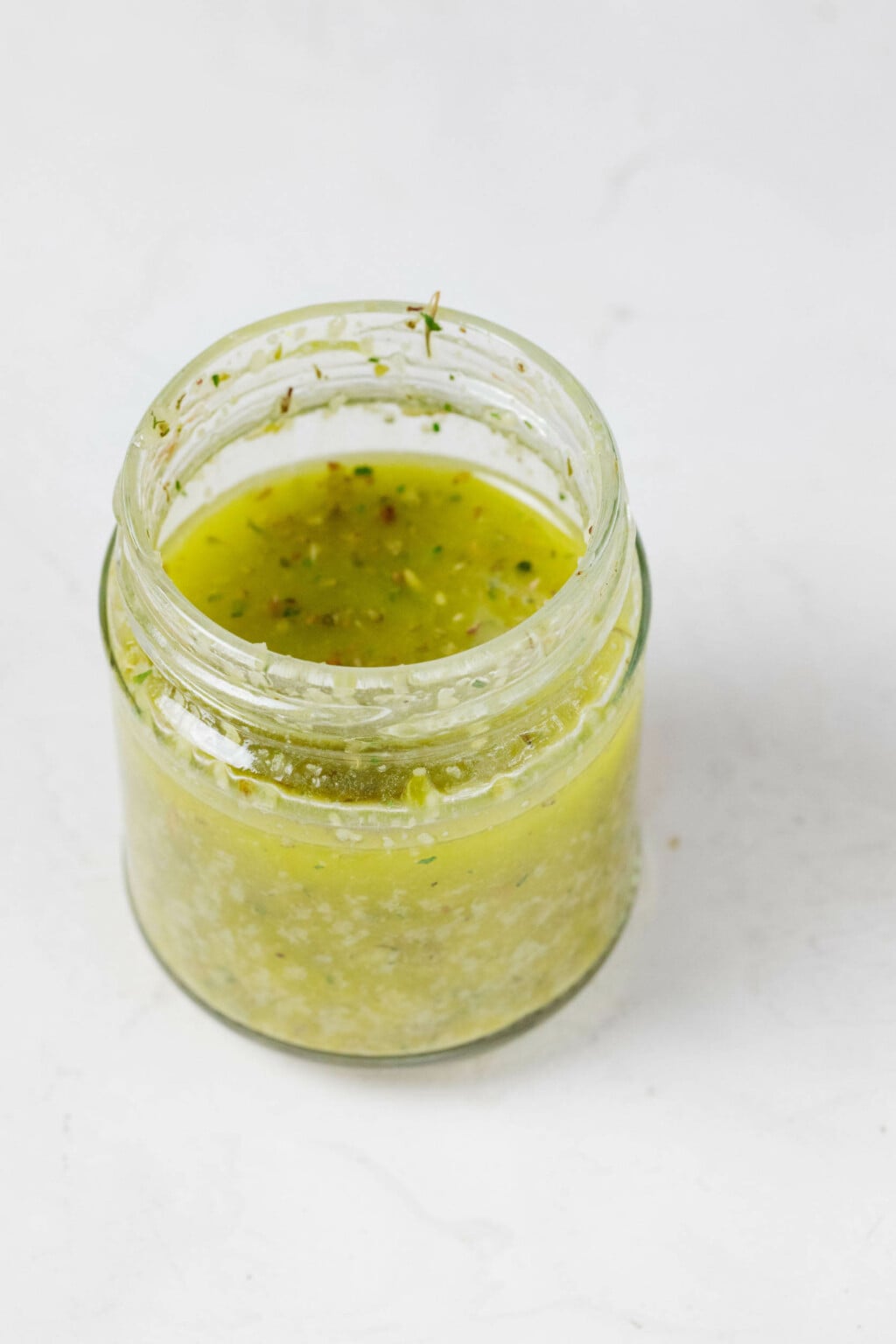
How to use vegan Italian dressing
I use this Italian dressing on all sorts of salads: kale salads, leafy green salads, raw chicory salads, and slaws made with shredded beets, carrots, or Brussels sprouts.
It’s a perfect vinaigrette for adding flavor and savoriness to cooked farro, barley, rice, or quinoa.
If you’d like to use the dressing on a vegan lunch bowl, here are some potential combinations of cooked ingredients. All could be served over any greens that you like:
- Farro, crispy roasted chickpeas, and broccoli
- Oven roasted eggplant cubes, quinoa, and white beans
- Pasta, lentils, and sun-dried tomatoes
- Roasted frozen cauliflower florets, chickpeas, and rice
- Baked balsamic tofu, quinoa, and grape tomatoes
The vegan Italian dressing could also be a nice marinade for any of the following:
- Tempeh strips
- Tofu slabs
- Slices of eggplant or zucchini
- Cauliflower steaks
- Seitan
I’d marinate the ingredients for a few hours in the fridge, then grill, bake, or pan-sauté them.
This is what makes a basic a basic! It’s one humble item that can be useful in countless ways.
And here’s the recipe.
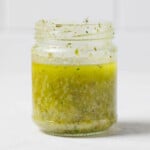
Yields: 0.75 cup
- 1/2 cup extra virgin olive oil
- 1/4 cup white wine vinegar
- 1 scant teaspoon maple syrup (optional; substitute agave syrup)
- 1 clove garlic, finely minced or grated on a microplane zester
- 1 1/2 teaspoons dried Italian seasoning (substitute a 1/2 teaspoon each dried basil, oregano and thyme)
- 2 tablespoons cashew parmesan cheese (substitute store-bought, grated vegan parmesan cheese or nutritional yeast)
- 1/4 teaspoon fine salt
- 1/8 teaspoon freshly ground black pepper
-
Place all ingredients into a mason jar, cover securely, and shake till emulsified. Alternatively, place all ingredients into a small mixing bowl or mason jar, then use a fork or small whisk to whisk them till emulsified. Store the dressing in an airtight container in the fridge for up to 1 week.
A big bowl of crunchy greens can be the most wonderful counterpart to warm winter meals. And this vegan Italian dressing is a perfect way to brighten them up.
I hope you’ll agree.
xo

